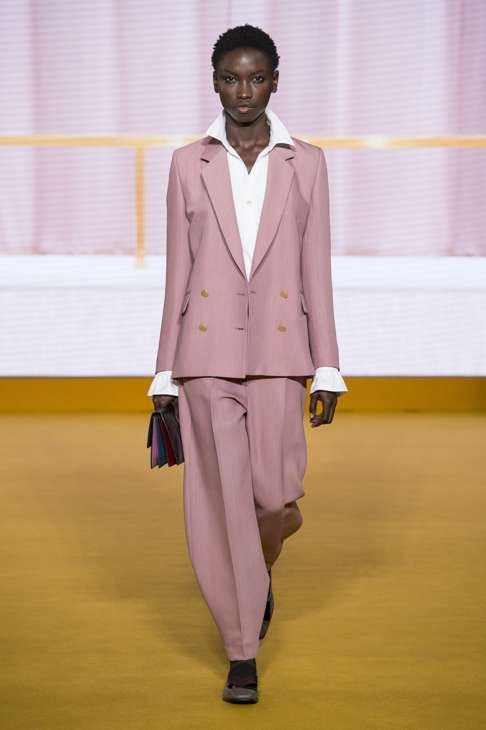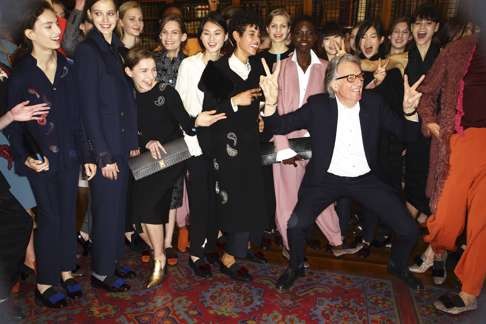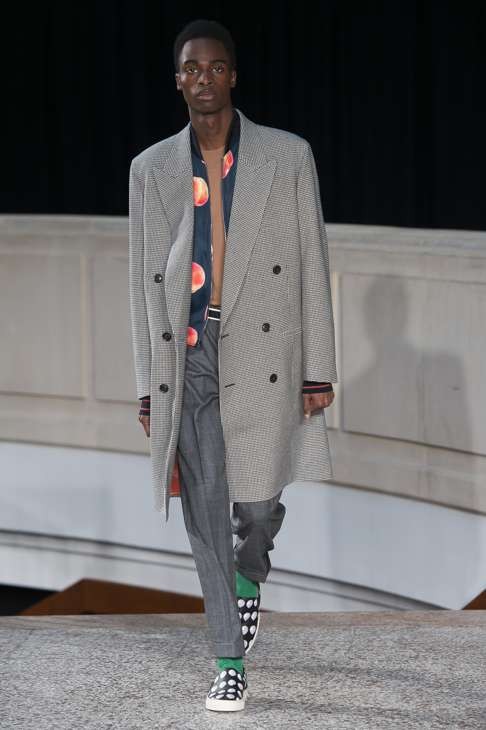
Designer Paul Smith in Hong Kong: the need to change holds no fear for this survivor
After four decades at the forefront of a cutthroat industry, fashion’s down-to-earth everyman shows no signs of slowing down. And he throws down a challenge to landlords on shop rents
“Are you all right?” asks a perturbed Paul Smith as I wince and gingerly take a seat next to him. We are in the Liang Yi Museum in Sheung Wan, surrounded by the British designer’s latest autumn-winter collections for men and women.
Conscious of limited time, I try to get on with the interview, but Smith coaxes the story out of me. I had recently injured myself in a rather awkward place while attempting to impress a lady. After some playful ribbing, Smith imparts a whole host of advice on wound care, even though we’re supposed to be talking about fashion and some big changes at his eponymous label.
But that’s typical Paul Smith. Working in the pressure cooker environment of high fashion, a business often associated with diva-like behaviour and outsized egos, the 69-year-old’s charm comes from his everyman personality, modesty and what he describes as “normalness”. Knighted in 2000 for services to fashion, Smith rarely, if ever, uses his title, and can’t fully remember if his credit card has it either.
“We’ve been successful, I think, because of people like me. I probably shouldn’t say it like that but what I mean is that I’m a normal bloke, I’m easy to talk to,” he says.

The fact that his company remains independently owned also resonates with customers today. “We get lovely letters from all around the world, literally every day. And then Instagram; some of the comments, they’re so charming and gentle and really nice.”
Nearing his seventh decade, Smith doesn’t seem any closer to slowing down and nor would he want to. Having flown into Hong Kong from Japan, he was due to fly back there that very evening. “Yeah, I still love it, the travel and all that. I’m blessed with this calmness about my life, I’m more ‘Yeah, of course, no problem; yeah, let’s get on with it’.”
He doesn’t do the late nights and parties he used to in his youth but a morning ritual helps immeasurably. “I swim every morning at 5am. I have done since 1992. Well, it was a bit difficult here as The Peninsula pool doesn’t open until 6.30am, but I try to start the day like that.”

Paul Smith the brand is something of an anomaly in the world of fashion; it has an annual turnover in excess of HK$2.2 billion yet is privately owned, has no debt and doesn’t have the airs of a large fashion conglomerate. Smith owns 60 per cent of his company, which allows him to make the decisions he feels are right for it; in particular, that means not standing still or relying on past glories.
“Nobody cares how good you used to be,” says Smith of the mantra that motivates him to keep innovating. The Briton has been at the forefront of the industry for more than four decades, something he puts down largely to his willingness to change – more so now than ever amid the rapid evolution of the fashion business and a transition to more austere economic times.
“Fashion’s about today and tomorrow. One of the dangers, and you see it with loads of brands, is they have a major success [with a product or print] or whatever and then they overcook it and then eventually it just goes into decline,” he says, before citing a lucrative example from his own company. “With my famous stripe print, I just stopped doing it. It cost me five million quid or something, but I just thought ‘No, no, no I’m stopping, it’s too easy’.”

Never afraid to make hard decisions, Smith, who decided to personally present his new collections in Hong Kong, has pushed through a major restructuring of his company, the official announcement of which comes in May.
In practical terms, it will be streamlined by folding some of the diffusion lines for men and women such as PS Jeans, Paul Smith Black and Paul Smith London into two lines for men and two for women simply titled Paul Smith and PS, which will be delivered to shops and retail partners four times a year.
“There’s too much product out there, not just in fashion but in everything,” says Smith, explaining the rationale behind the changes. “Even big brands have started to see a decrease in sales, more difficult times and all of that. So it’s a good time to refocus.”
The main line, Paul Smith, will feature suiting, dresses and more luxurious items, with the more accessibly priced PS collection focusing on more casualwear.

Autumn-winter 2016 will be the first collection from the newly rationalised Paul Smith brand and the designer says it’s an exciting one, as it touches upon his own extensive archive but through the “fresh eyes” of his young design team, many of whom are in their 20s.
“I took some of them up to Nottingham [in central England, where Smith opened his first boutique] to see our archive, and seeing it through their eyes was really, really interesting,” Smith says.
The archive has inspired a collection that features looser cuts and shapes, once again a step away from the skinny silhouettes that so dominated the catwalk for more than a decade. “One of the things that [my design team] liked was a lot of the things from 20, 30 years ago and a lot bigger fit,” Smith says.

Among other things, Smith is bringing back an overcoat he designed three decades ago, along with photo prints he made at the start of his career, in particular an apple print for womenswear and peaches for menswear. “The apple one, that was one of the first photographic prints I ever did in my life and we just reproduced it again because it looked so right.”
Despite taking the decision to streamline his collections, Smith has held back from following Burberry, Tommy Hilfiger and Tom Ford,which all recently announced that they were adopting a see-now-buy-now model of immediate purchase, moving away from the traditional six-month wait for designs to go from catwalk to store.
“I think we need to see how that works with people that have decided that’s what they’re going to do because from a business point of view, and production point of view, it’s very complicated,” says Smith, outlining his own reservations. “You would have had to commit to fabric and production three or four months before and so how do you know that’s going to sell or not sell. So you know it’s massively dangerous unless they have things which are just basics, and then in that case what’s the point? So it will be interesting to see,” he says.

The Nottingham-born designer is an animated talker, all hand gestures, warm humour and candour. He doesn’t believe in glossing over the real dangers facing his industry, in particular the high rents in cities such as Hong Kong.
“Fashion has changed so massively and my biggest ‘shop’ now is the internet. We’ve seen a 46 per cent increase there, which is ridiculous, and yet [in] shops around the world the rents still go up.”
Smith then offers a stark warning to property companies: “Very soon they are going to have to get real. They’re going to have to really think if they can keep [rents high], otherwise you will have empty shops because there’s more business going towards the internet.”

During his brief trip to Hong Kong, he’s even had conversations about some brands looking to reduce the size of their shops to make them work financially. This forthrightness on rents and debt is something he attributes to his northern English upbringing and which marks him out in the industry as “old school”.
“We have no debt; I own the building in Mayfair {in London] so there’s no rent, I own my warehouses in Nottingham. I own my headquarters in Covent Garden in London,” Smith says, adding: “I bet there’s a lot of brands out there that would quite like to be old school right now.”

